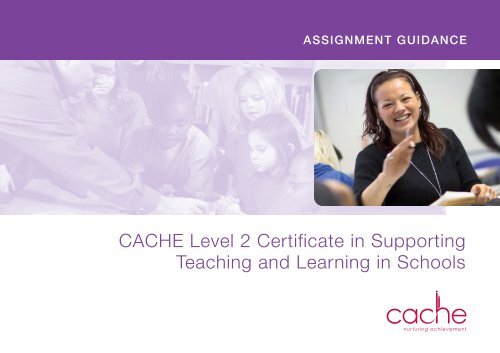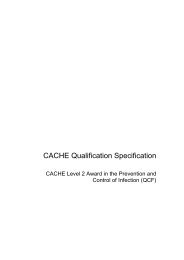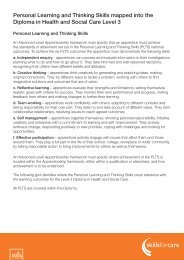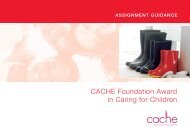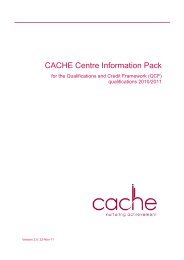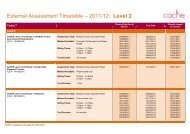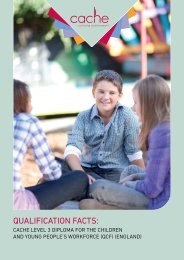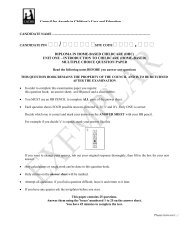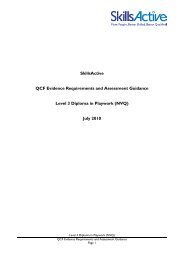Assignment Guidance - Cache
Assignment Guidance - Cache
Assignment Guidance - Cache
You also want an ePaper? Increase the reach of your titles
YUMPU automatically turns print PDFs into web optimized ePapers that Google loves.
ASSIGNMENT GUIDANCECACHE Level 2 Certificate in SupportingTeaching and Learning in Schools
CACHE Level 2 Certificate in Supporting Teaching and Learning in Schools© CACHE 2009Except as allowed by law, or where specified in the text, no partof this publication may be reproduced or transmitted in any formor by any means without prior permission from the Council forAwards in Children's Care and Education.Published in Great Britain by CACHEFirst edition 2009500/5436/3/V2/AGV1Publication date: September 2009Publisher:Council for Awards in Children's Careand EducationApex House81 Camp Road, St Albans, AL1 5GBTelephone: 0845 347 2123Fax: 01727 818618Registered Company No: 2887166Registered Charity No: 1036232Océ Ref: 412770A
Level 2 Certificate in Supporting Teaching and Learning in SchoolsCACHE Level 2 Certificate in Supporting Teaching and Learning in SchoolsThis assignment guidance is intended to assist tutors and candidates to understand the requirements of the assignment criteria. It includes some examples of ways to meetthe criteria. Tutors and candidates will be able to apply knowledge and understanding to provide relevant and detailed information.This guidance does not indicate the requirements for a specific grade.© CACHE 2009 2
Unit 1 – Teaching and learning in schoolsLevel 2 Certificate in Supporting Teaching and Learning in SchoolsUnit 1 – Teaching and learning in schools<strong>Assignment</strong> task:What do I have to do?You are working as a teaching assistant in a school. Your role is to provide support to the teacher to deliver the curriculum to children and young people in one of thefollowing age ranges:• 0 – 3 years or• 3 – 7 years or• 7 – 12 years or• 12 – 16 yearsChoose ONE (1) age rangeIn your everyday work you use your knowledge of the development of children and young people to plan and evaluate learning activities which relate to the appropriatecurriculum, observe children and young people and support them through key transitions in their lives.Choose ONE (1) area of development in which you can identify activities that will support learning:• physical development• communication development• intellectual development• social and emotional development• behavioural development.3 © CACHE 2009
Level 2 Certificate in Supporting Teaching and Learning in SchoolsUnit 1 – Teaching and learning in schoolsIn your role as a teaching assistant the teacher has asked you to provide information relating to your chosen age range about:• your chosen area of development• two activities which will support learning in this area of development• strategies to ensure learning in one of the activities• the reasons to use observations• the importance of play opportunities• transitions which children and young people may experience• the relationship between the roles of the teaching assistant and teacher.Your completed work should not exceed 2,000 words. There is no lower word limit. Work that is more than 10% above the word limit will not be marked. Referencesand quotations within the text are not included in the word limit.© CACHE 2009 4
Unit 1 – Teaching and learning in schoolsLevel 2 Certificate in Supporting Teaching and Learning in Schools<strong>Assignment</strong> <strong>Guidance</strong>Unit 1 – Teaching and learning in schoolsCriteria Description <strong>Guidance</strong>P1P2P3P4P5State the chosen age range and area of development ANDdescribe the development of the children or young people inthis chosen age range.Identify factors which may affect this chosen area ofdevelopment.Describe how this chosen area of development affects otherareas of children and young peoples’ holistic development.Describe TWO (2) activities which will support children oryoung peoples’ learning in this area of development.Select ONE (1) of the identified activities in P4Describe how the teaching assistant can support children oryoung peoples’ learning in this activity.Clearly identify ONE (1) of the age ranges from 0 – 3 years, 3 – 7 years,7 – 12 years or 12 – 16 years.Choose an area of development from physical development, communication development,intellectual development, social and emotional development OR behavioural development.Write about the main stages of this area of development within the chosen age range e.g.physical development for children aged 3 – 7 years. The main stages of physical developmentfor children aged 3 – 7 years are.....List several factors that affect the area of development chosen in P1 within the age rangechosen in P1. Factors could include additional learning needs, home life and other relevantfactors.Give examples of how the area of development chosen in P1 affects other areas ofdevelopment for children in the chosen age range e.g. regular exercise and opportunities todevelop physical skills can promote self-esteem and social and emotional development by......Select TWO (2) activities which are suitable for children or young people within the chosenage range for the area of development chosen in P1. Write about BOTH activities in a waythat shows how the activities can contribute to learning in the area of development. Examplesfrom experience in classrooms may be used.Choose ONE (1) of the activities identified in P4. Write about ways the teaching assistant canhelp children or young people’s learning from this activity e.g. by praising pupils’ efforts theteaching assistant can promote self esteem and help to increase each pupil’s confidence to trythis activity which involves learning about.....P6 Explain how this activity relates to the appropriate curriculum. Provide details about how the activity chosen in P5 links to the curriculum used in the countrywhere you are studying, for the children or young people in the chosen age range.P7Give reasons why the teaching assistant should observechildren and young people regularly.Give more than one reason, relating to the chosen age range, that clearly shows why it isimportant that the teaching assistant observes children and young people regularly e.g.regular observations which help the teaching assistant to stay aware of children’s changinginterests or to monitor behaviour to support learning and development.5 © CACHE 2009
Level 2 Certificate in Supporting Teaching and Learning in SchoolsUnit 1 – Teaching and learning in schools<strong>Assignment</strong> <strong>Guidance</strong> – ContinuedUnit 1 – Teaching and learning in schoolsCriteria Description <strong>Guidance</strong>P8P9Explain why children or young people in your chosen agerange should be given opportunities for play.Describe how the teaching assistant might support a child oryoung person through a transition.Give more than one reason why children or young people in the chosen age range should begiven opportunities for play e.g. play encourages children to practice life skills such as makingchoices and decisions.....Write about the ways that a teaching assistant can help a child or young person duringtransitions such as starting a new setting, moving classes, moving house, family changes,entering the work place or college. Ways should be suitable for the chosen age range and caninclude the teaching assistant supporting the child during discussions, visits, researchingopportunities.P10 Include references and a bibliography. Include at least TWO (2) published references within the text AND provide a list of books,articles, magazines or websites in a bibliography at the end of the assignment. See the currentFinding the Level and the compensatory marking scheme for additional guidance.M1M2D1Explain the role of the teaching assistant in motivating childrenand young people and ensuring they stay on task.Explain how the teaching assistant can use observations tosupport the teacher.Explain the responsibilities of the teaching assistant inmaintaining an effective relationship with the teacher.Provide details with reasons about how and why the teaching assistant should promotechildren and young people’s desire to learn and their interests as well as helping them to stayon task e.g. the teaching assistant can encourage children by providing activities that thechildren are interested in….. The teaching assistant can break tasks down into smaller stepsin order to help children concentrate on the task.An extension of P7. This should focus on how the teaching assistant can help the teacher. Thismay include the teaching assistant keeping records from observations that the teacher canuse in planning and assessment or the teaching assistant having different opportunities toobserve progress during small group activities.Provide details which give more than one aspect of the responsibilities of the teachingassistant in maintaining an effective relationship with the teacher e.g. responsibilities such asmaintaining confidentiality/teamwork/planning can be maintained by.....The explanation needs to consider the teaching assistant’s responsibility to foster an effectiverelationship. This may involve consideration of reasons why relationships may be lesseffective.© CACHE 2009 6
Unit 2 – Effective communication within a safe environmentLevel 2 Certificate in Supporting Teaching and Learning in SchoolsUnit 2 – Effective communication within a safe environment<strong>Assignment</strong> task:What do I have to do?You have been asked to produce an information file with the title:‘Effective communication within a safe environment’This information file is to support your own work in a school setting. The file should include information about:• legislation, policies and procedures for keeping children safe• effective communication with children and adults• team work and improving practice.Your completed work should not exceed 2,000 words. There is no lower word limit. Work that is more than 10% above the word limit will not be marked. Referencesand quotations within the text are not included in the word limit7 © CACHE 2009
Level 2 Certificate in Supporting Teaching and Learning in SchoolsUnit 2 – Effective communication within a safe environmentUnit 2 – <strong>Assignment</strong> <strong>Guidance</strong>Unit 2 – Effective communication within a safe environmentCriteria Description <strong>Guidance</strong>P1P2P3P4P5P6Key legislation which supports practitioners to keep childrensafe.Why it is important to follow the policies and procedures inschools which help to keep children safe.The behavioural changes and physical indicators which maybe signs of child abuse.Strategies which the teaching assistant and teacher can use toencourage children to keep themselves safe.Strategies the teaching assistant might use to encouragepositive behaviour in the classroom.Key features of effective communication with adults ANDpupils.Identify by listing or naming some of the main laws that underpin the provision of healthy, safeand secure environments for young children. Give the full title and date of each law such asThe Health and Safety Act 1974.Give reasons to follow the policies and procedures, such as, meet the requirements oflegislation; maintain health and safety; understand emergency procedures.Give more than one example of the behavioural and physical changes which may be signs ofchild abuse. Show an understanding of the four main types of abuse and the signs which mayindicate abuse e.g. a child who shows aggression in role play situations, a child who clings toan adult for affection.Give more than one clear strategy for encouraging children to keep themselves safe.Strategies could include how to manage risk and challenge, empower children to developindependence and the skills to make reasoned judgements e.g. children may feel able to keepthemselves safe when they build a trusting relationship with known adults because……Give more than one strategy to show how to encourage positive behaviour such as praise,distraction, consistency. Practical examples involving following the setting’s policies andprocedures may be given.Give the main factors that make communication effective with all adults in the setting AND withpupils. Features of communication with pupils should be age-appropriate. Relevant practicalexamples could be given for adults and pupils e.g. when listening to pupils give them time tosay what they want by…..P7 The skills needed to be an effective team member. State the professional skills such as being self-aware, reflective, showing interest, reliability,flexibility and openness, valuing and respecting everyone e.g the ability to follow instructionsis a skill which contributes to being an effective team member…..P8 The benefits of team discussions. Identify or list a range of benefits of sharing information with colleagues such as benefits toself, other team members, parents and children. Benefits could include keeping children safe,planning and organisation, improving outcomes for children.© CACHE 2009 8
Unit 2 – Effective communication within a safe environmentLevel 2 Certificate in Supporting Teaching and Learning in Schools<strong>Assignment</strong> <strong>Guidance</strong> – ContinuedUnit 2 – Effective communication within a safe environmentCriteria Description <strong>Guidance</strong>P9The ways that teaching assistants can obtain information tohelp them to improve their practice.Give a variety of sources of information for improving own learning and performance. Includeways to improve practice such as peer observations, use of PDPs, how to use feedback, useof reflective analysis and self evaluation e.g. teaching assistants can improve their practice byasking for feedback on their performance to……P10 Include references and a bibliography. Include at least TWO (2) published references within the text AND provide a list of books,articles, magazines or websites in a bibliography at the end of the assignment. See the currentFinding the Level and the compensatory marking scheme for additional guidance.M1M2D1Explain the main differences between communicating withadults and communicating with pupils.Explain how pupils’ abilities to communicate may affect theirbehaviour in the classroom.Explain why teaching assistants should continuously developand improve their practice.An extension of P6. Show how to use different methods of communicating and the differentpurposes of communicating such as communication with pupils which often involves trying toteach something and how this would differ from trying to explain something to an adult.Differences such as level of language and preferred method of address might be included.Think carefully and write about pupils’ different abilities to communicate and pupils such asthose with communication difficulties and bilingual children. Effects may be that children arefrustrated or lack confidence and self esteem. Explanations should show positive and negativeaspects of behaviours according to children’s abilities to communicate e.g. a child who has aspeech delay may..…, however a child who has a wide vocabulary may…..Give reasons such as the benefits to all pupils by helping them to meet their full potential; torelate to legislation, policies and procedures; to follow developments in current practice; toprovide the best environment for children to develop independence in learning. Theexplanation could consider the role of reflective practice.9 © CACHE 2009


